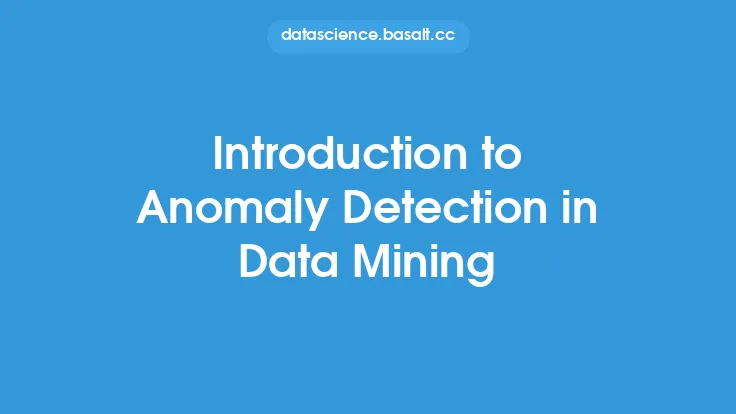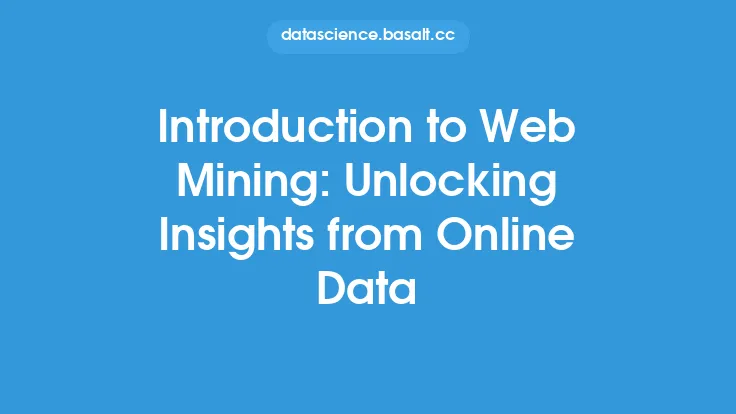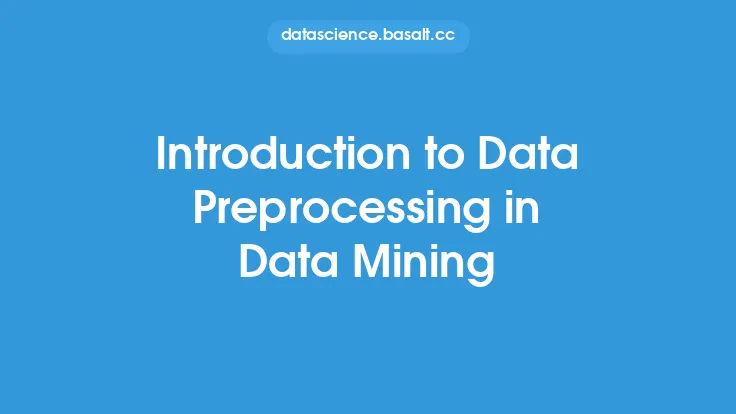Data mining is the process of automatically discovering patterns and relationships in large datasets, with the goal of extracting valuable insights and knowledge. It involves using various techniques and algorithms to analyze and interpret complex data, often from multiple sources. Data mining techniques are essential in today's data-driven world, where organizations and businesses need to make informed decisions based on data analysis. In this article, we will delve into the fundamentals of data mining techniques, exploring their types, applications, and benefits.
Types of Data Mining Techniques
There are several types of data mining techniques, each with its own strengths and weaknesses. Some of the most common techniques include:
- Predictive Modeling: This involves using statistical and machine learning algorithms to predict future outcomes based on historical data. Predictive modeling is widely used in applications such as credit risk assessment, customer churn prediction, and sales forecasting.
- Descriptive Modeling: This type of technique is used to identify patterns and relationships in data, without making predictions. Descriptive modeling is often used in applications such as market basket analysis, customer segmentation, and social network analysis.
- Prescriptive Modeling: This involves using optimization algorithms to recommend actions or decisions based on data analysis. Prescriptive modeling is commonly used in applications such as supply chain optimization, resource allocation, and portfolio optimization.
Data mining techniques can be further categorized into two main types: supervised and unsupervised learning. Supervised learning involves training algorithms on labeled data, where the target variable is known. Unsupervised learning, on the other hand, involves analyzing unlabeled data to identify patterns and relationships.
Data Mining Process
The data mining process typically involves several stages, including:
- Problem Formulation: This stage involves defining the problem or opportunity that data mining can address. It requires identifying the key performance indicators, data sources, and stakeholders involved.
- Data Collection: This stage involves gathering data from various sources, including databases, files, and external data providers. Data collection requires ensuring data quality, handling missing values, and transforming data into a suitable format.
- Data Preprocessing: This stage involves cleaning, transforming, and preparing data for analysis. Data preprocessing includes handling outliers, removing duplicates, and normalizing data.
- Pattern Discovery: This stage involves applying data mining algorithms to identify patterns and relationships in data. Pattern discovery requires selecting the most suitable algorithm, tuning parameters, and evaluating results.
- Pattern Evaluation: This stage involves evaluating the discovered patterns to ensure they are meaningful, reliable, and useful. Pattern evaluation requires using metrics such as accuracy, precision, and recall to assess the quality of the results.
- Deployment: This stage involves deploying the data mining model into a production environment, where it can be used to make predictions, recommendations, or decisions.
Data Mining Tools and Technologies
There are several data mining tools and technologies available, including:
- R: A popular programming language and environment for statistical computing and data visualization.
- Python: A versatile programming language with extensive libraries and frameworks for data mining, including scikit-learn, TensorFlow, and PyTorch.
- SQL: A standard language for managing relational databases, often used for data mining and business intelligence applications.
- NoSQL: A variety of non-relational databases, including key-value stores, document-oriented databases, and graph databases, often used for big data and real-time analytics.
- Data Mining Software: Specialized software packages, such as SAS, SPSS, and Oracle Data Miner, that provide a comprehensive set of data mining tools and techniques.
Data mining tools and technologies are constantly evolving, with new advancements in areas such as cloud computing, artificial intelligence, and the Internet of Things (IoT).
Applications of Data Mining
Data mining has numerous applications across various industries, including:
- Marketing: Data mining is used to analyze customer behavior, preferences, and demographics, enabling targeted marketing campaigns and personalized recommendations.
- Finance: Data mining is used to detect credit card fraud, predict stock prices, and optimize investment portfolios.
- Healthcare: Data mining is used to analyze medical records, predict disease outcomes, and optimize treatment plans.
- Retail: Data mining is used to analyze customer purchasing behavior, optimize inventory management, and improve supply chain efficiency.
- Government: Data mining is used to analyze demographic data, predict crime patterns, and optimize public services.
Data mining applications are diverse and continue to expand, as organizations and businesses recognize the value of data-driven decision-making.
Benefits of Data Mining
The benefits of data mining are numerous, including:
- Improved Decision-Making: Data mining enables organizations to make informed decisions based on data analysis, rather than relying on intuition or guesswork.
- Increased Efficiency: Data mining automates many tasks, such as data analysis and pattern discovery, freeing up resources for more strategic activities.
- Enhanced Customer Experience: Data mining enables organizations to personalize customer interactions, improve customer satisfaction, and increase loyalty.
- Competitive Advantage: Data mining provides organizations with a competitive edge, enabling them to identify new opportunities, anticipate market trends, and respond to changing customer needs.
- Cost Savings: Data mining can help organizations reduce costs by optimizing resources, streamlining processes, and minimizing waste.
Data mining has become an essential tool for organizations and businesses, enabling them to extract valuable insights from large datasets and make data-driven decisions.
Challenges and Limitations of Data Mining
Despite its many benefits, data mining also poses several challenges and limitations, including:
- Data Quality: Data mining requires high-quality data, which can be difficult to obtain, especially in cases where data is incomplete, inaccurate, or inconsistent.
- Data Privacy: Data mining raises concerns about data privacy, as it often involves analyzing sensitive information about individuals, such as personal data, financial information, or health records.
- Complexity: Data mining can be complex, requiring specialized skills, knowledge, and expertise, especially when dealing with large datasets or advanced algorithms.
- Interpretation: Data mining results can be difficult to interpret, requiring a deep understanding of the underlying data, algorithms, and business context.
- Overfitting: Data mining models can suffer from overfitting, where the model is too closely fit to the training data, resulting in poor performance on new, unseen data.
Data mining challenges and limitations highlight the need for careful planning, execution, and evaluation of data mining projects, as well as ongoing investment in data quality, talent, and technology.
Future of Data Mining
The future of data mining is exciting and rapidly evolving, with new advancements in areas such as:
- Artificial Intelligence: AI and machine learning are becoming increasingly important in data mining, enabling organizations to automate complex tasks, improve accuracy, and uncover new insights.
- Big Data: The growth of big data is driving the development of new data mining techniques, such as distributed computing, parallel processing, and streaming analytics.
- Cloud Computing: Cloud computing is enabling organizations to scale data mining operations, reduce costs, and improve collaboration.
- Internet of Things: The IoT is generating vast amounts of data, which can be analyzed using data mining techniques to improve operational efficiency, predict maintenance, and enhance customer experience.
- Real-Time Analytics: Real-time analytics is becoming increasingly important, enabling organizations to respond quickly to changing market conditions, customer needs, and business opportunities.
The future of data mining holds much promise, as organizations and businesses continue to recognize the value of data-driven decision-making and invest in the latest technologies, tools, and techniques.





